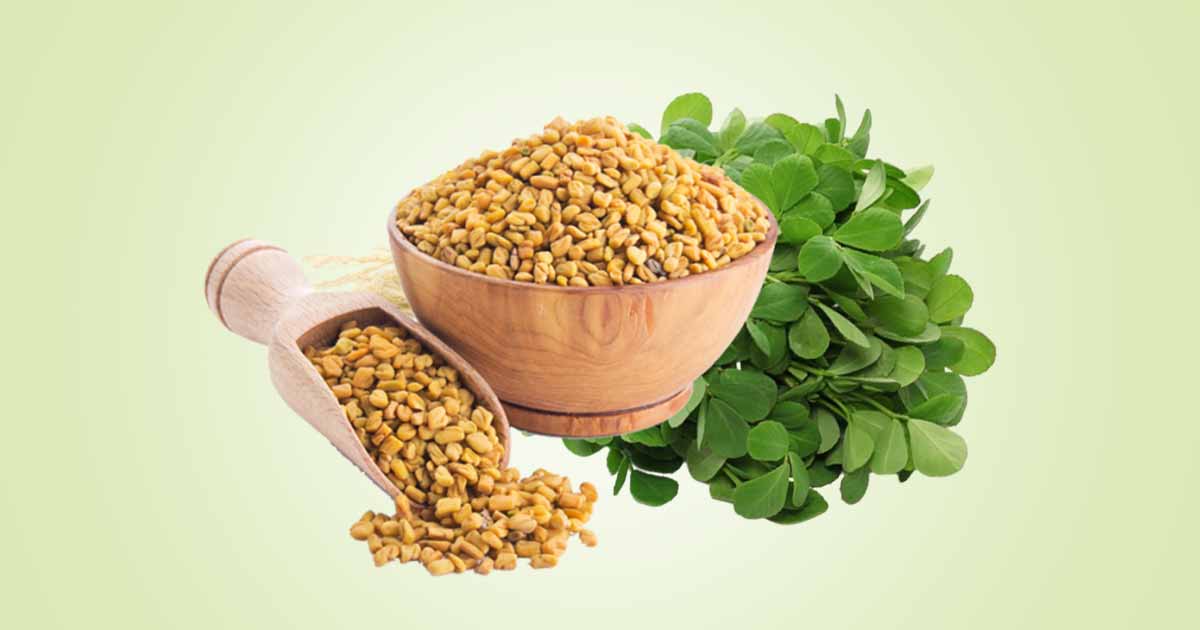Fenugreek (Trigonella foenum-graecum) is a herbal plant and spice from the family, Fabaceae. The Latin name, “foenum-graecum” means Greek hay. The herb originates from the South-Eastern Europe and Western Asia. It is now grown in India, the USA, France, Belgium, Spain, Hungary, Northern Africa, Near East, Western Asia, Austria, Ethiopia, Chile, Argentina, China.
It is an erect, smooth, taprooted, herbaceous and leguminous plant, which can grow up to 40-80 cm height. The stem is erect, and can be branched. The leaves are light green, while the leaflets are oval, with hairs on the lower surface. Flower are lemon-yellow or purplish blue in color, and are borne on leaf axils.
The fruit is a thin, pointed, straight or sickle-like pod that contain 10 to 20 seeds. Fenugreek seed is oblong or square, green-olive or brownish colored. It has a strong and spicy aroma, and bitter taste.
Fenugreek is grown in cool season in India and the Mediterranean region. Naturally, it is found in the field verges, uncultivated ground, dry grasslands and hillsides in semi-highland and highland regions.
There are two types – the regular municipal fenugreek, of yellowish color, and the red fenugreek, known as the horse fenugreek.
Fenugreek is also called Methi, Greek hay, Greek clover, Trigonella, Alholva, Bird’s Foot, Bockshornsame.
Other names include fenugrec (French), Hulba (Arabian), Bockshornklee (German), halba (Malay), kelabat (Indonesian/Javanese), fieno greco (Italian), trigonelle, sénégrain (French), Çemen otu (Turkish), Pazhitnik (Russian), Alholva (Spanish), and Methi (Hindi).
The plant is harvested for the seed. Fenugreek seed is edible, and also a spice. The seed oil is used to flavor butterscotch, cheese, licorice, pickles, rum, maple syrup, vanilla, cheese, and curries. It is also used in perfumery, and cosmetics.
It is a source of diospenin, used to synthesize hormones. The seed husk also contains mucilage, oil, sapogenin and protein. In Egypt, it is used as a supplement in wheat and maize flour for bread making.
In traditional medicine, it has been used as a tonic, to treat weakness and edema in legs, urolithiasis, nephrolithiasis, kidney problems, indigestion, baldness, aid labor and delivery.
Fenugreek has anticancer, antioxidant, anti-diabetic, wound healing, aphrodisiac, astringent, gastroprotective, anticancer, demulcent, hypocholesterolemic, anti-inflammatory effects.
Composition
Fenugreek contains gum, saponins, hemicelluloses, mucilage, tannins and pectin, dietary fiber, alkaloid, flavonoids, coumarins, and volatile content.
It also contains saturated fatty acids, and amino acids. Glutamic acid, aspartic acid, arginine, leucine, lysine, and glycine are of major quantities among the amino acids. Others include proline, serine, alanine, methionine, tryptophan, tyrosine, phenylalanine, isoleucine, threonine, histidine, valine, and cystine. There is also free unnatural amino acids (4- hydroxyisoleucine).
The seed husk and cotyledons has high saponin content. The husk also has high polyphenols, dietary fibers, and antioxidant levels.
- Flavonoids: luteolin, tricin, naringenin, vitexin, and quercetin.
- Saponins: graecunins, fenugrin B, fenugreekine, trigofoenosides A – G.
- Alkaloids: trigonelline, choline, gentianine, carpaine, betaine, neurin, trimethylamine.
- Steroidal sapiogens: diosgenin, gitogenin, yamogenin, smilagenin, saponaretin, trigogenin, yaccagenin, neotigogenin.
- Volatile compounds: 1-Octen-3-one, (Z)-1,5-Octadiene-3-one, 3-Isopropyl-2-methoxy pyrazine, Acetic acid, 3-Isobuty-2-methoxy pyrazine, linalool, butanoic acid, isovaleric acid, caproic acid, eugenol, 3-Amino-4,5-dimethyl 3, 4-dihydro-2-(5H) furanone, and stolon.
Nutritional Composition
A 100g of fenugreek seeds contain 8.84 g of water, 23g of protein, 6.41 g of fats, 3.4 g of ash, 58.4 g of carbohydrates, 24.6 g of dietary fiber, and 323 kcal of energy.
Mineral content: The spice contains high potassium (770 mg), phosphorus (296 mg), magnesium (191 mg), and calcium (176 mg) value. Other minerals such as sodium (67 mg), iron, zinc, copper, selenium, and manganese are obtained.
Vitamins: Vitamin C, folate, thiamine, riboflavin, niacin, vitamin B-6, vitamin A.
Health Benefits of Fenugreek Seeds
Anti-diabetic effect: Fenugreek is hypoglycemic due to the constituent, trigonelline, an alkaloid. The high dietary fiber, which is as much as 52% of fenugreek seeds also contribute to the anti-diabetic activity. It reduced fasting blood sugar, postprandial glucose response, urinary glucose excretion, and improved insulin sensitivity.
Srinivasan (2006) reported that the daily consumption of 100 g defatted fenugreek seed powder for 10 days improved glucose tolerance.
The mechanism of action could also be inhibition of production of lipid, and glucose in the liver. It may also encourage utilization of glucose in the liver and muscle, increase glucos.e uptake by a mechanism similar to, but independent of, the presence of insulin (via GLUT4)
In animal models of diabetic nephropathy, fenugreek seeds, combined with onion, protected the kidney.
Anthelmintic activity: The alcoholic extract of seeds of fenugreek has a potential anthelmintic activity, by paralyzing the earthworm, Pheritima posthuma, as compared to death of the earthworm when treated with standard drug, albendazole.
Antioxidant effect: The seed and aerial parts of the plant exhibit radical scavenging activity and prevent oxidation of lipids, hemolysis in RBC. Germinated seeds contain more polyphenols, and flavonoids than dried seeds, hence they have more antioxidant effects.
High dietary fiber content: Dietary fiber lowers the level of low density lipoprotein-cholesterol (LDL) in blood and decrease bile salts reabsorption in the colon. It also protects the colon mucus membrane from cancer toxins. Other effects include the lowering of rate of glucose absorption in the intestines.
As a prebiotic, it modulates the intestinal flora. Galactomannan, a major soluble fiber in the endosperm of the seed also reduces the uptake of bile salts in the intestine and also the digestion and absorption of starch in the body. Galactomannan also acts as a stabilizer for food.
Weight loss: Protein and dietary fiber increase the secretion of the anorexigenic and insulinotropic hormone, glucagon-like peptide-1 (GLP-1) to improve glucose tolerance and reduce weight gain.
It slows down digestion, absorption of food from intestine, removes carbohydrates from the body system, and reduce body and adipose tissue weight.
Treat constipation: Dietary fiber prevents constipation and the development of diverticulosis and diverticulitis. It bulks up the waste, soften the stool by water retention. It also reduces the transit time
through the intestine due to the laxative effect.
Anticancer effect: High dietary fiber lowers the risk of colon cancers and irritable bowel syndromes. Fenugreek seed also prevents cancer by modulating the activities of β-glucoronidase and mucinase. β-glucoronidase decrease the free carcinogens, while mucinase helped to hydrolyze the protective mucin.
The seed extract exhibited potential protective activity against 7, 12-dimethylbenz (a) anthracene (DMBA)-induced breast cancer in rats at 200 mg/kg.
Lipid lowering effect: The fenugreek seed lowered serum cholesterol, low density lipoprotein (LDL), and triglyceride, and improved high density lipoprotein (HDL) in human patients. The activity is attributed to the soluble fiber such as beta-glucans or galactomannans that act by binding the bile acids, leading to its excretion.
This hypocholesterolaemic and hypertriglyecridaemia effects could be utilized in nutraceutical and functional foods’ production.
As a galactogogue: The seed has been used to boost lactation in breastfeeding mothers. Turkyılmaz et al. (2011) suggested that the estrogen-like compounds: phytoestrogens and diosgenin in fenugreek appear to increase in milk flow.
It is also reported that supplementation with 2 to 3 capsules (580 or 610 mg) of fenugreek 3 times a day may cause an increase in milk supply.
Reduce inflammation/analgesia: The fenugreek seed has constituents such as flavonoids that prevent inflammation and pain.
Fenugreek benefit to men and women: The seed may increase libido, low testosterone and sperm levels, and enhance sexual function in middle age men with androgen deficiency symptoms.
In women, it could reduce menopausal and dysmenorrhea symptoms, including menstrual pain, fatigue, headache, nausea, and lack of energy. This benefit is attributed to steroidal saponins like diosgenin, tigogenin, neotigogenin, and yamogenin, and phytoestrogens.
Hair growth: Fenugreek may promote hair growth, improve hair volume when the oil is applied to the scalp. It also prevents dandruff. The mechanism is not clear, but fenugreek may slow down the ability of dihydrotestosterone (DHT) to attach to your hair follicles.
DHT attach to hair follicles and cause hair loss.
Drug Interactions
Since fenugreek has high potassium levels just as bananas, plantains, tomatoes, it could interact with blood pressure lowering drugs such as the captopril and moexipril (ACE inhibitors)
- As fenugreek lowers blood pressure, it may also interact with anti-diabetic drugs, causing blood sugar to drop too low.
- As it may slow down clotting, it may also interact with medications that slow blood clotting (Anticoagulant / Antiplatelet drugs) like clopidogrel, warfarin, and supplements like clove, panax ginseng, turmeric, ginger, garlic, willow.
Side Effects
Fenugreek is safe in the amount used in food. However, larger doses may cause allergic reaction, and dangerous drop in blood pressure. Other side effects are nausea, diarrhea, bloating, indigestion, and, rarely, dizziness and headaches. It can also result in liver toxicity.
Do not use fenugreek supplements in children.
In Pregnancy and Breastfeeding
Do not use large quantity of fenugreek in pregnancy as it may increase the risk of birth defects.
References
- https://fdc.nal.usda.gov/fdc-app.html#/food-details/171324/nutrients
- https://www.feedipedia.org/node/242
- https://www.sciencedirect.com/topics/agricultural-and-biological-sciences/fenugreek
- https://applications.emro.who.int/imemrf/Nutr_Food_Sci_Res/Nutr_Food_Sci_Res_2016_3_1_5_16.pdf
- https://www.researchgate.net/publication/279038848_Fenugreek_Trigonella_foenum_gracum_L_and_its_necessity_A_Review_Paper
- https://actascientific.com/ASMI/pdf/ASMI-03-0726.pdf
- https://www.webmd.com/skin-problems-and-treatments/hair-loss/what-to-know-fenugreek-hair-growth












